Jeremiah D. Deng
Efficient Quantum Approximate $k$NN Algorithm via Granular-Ball Computing
May 29, 2025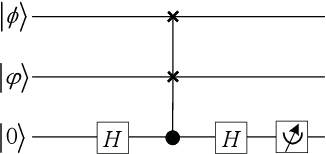
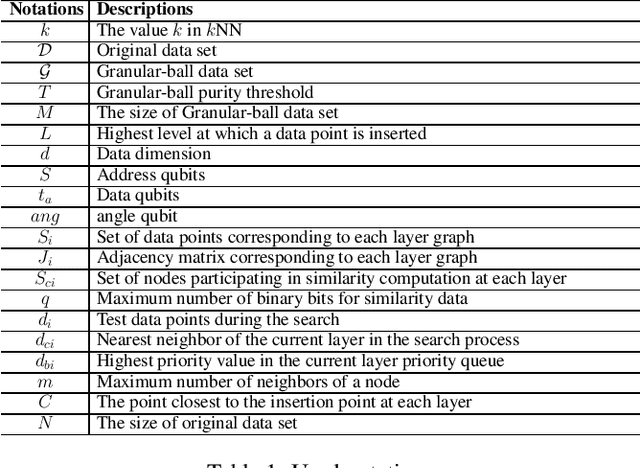
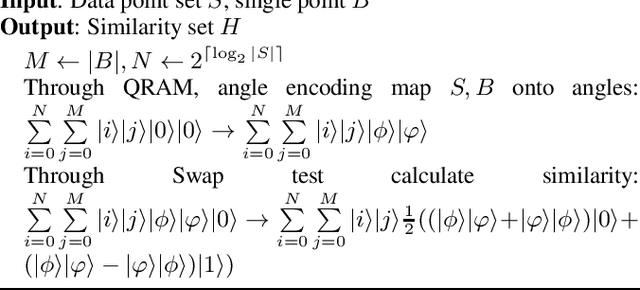
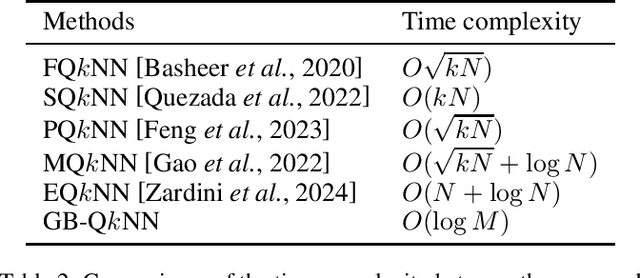
Abstract:High time complexity is one of the biggest challenges faced by $k$-Nearest Neighbors ($k$NN). Although current classical and quantum $k$NN algorithms have made some improvements, they still have a speed bottleneck when facing large amounts of data. To address this issue, we propose an innovative algorithm called Granular-Ball based Quantum $k$NN(GB-Q$k$NN). This approach achieves higher efficiency by first employing granular-balls, which reduces the data size needed to processed. The search process is then accelerated by adopting a Hierarchical Navigable Small World (HNSW) method. Moreover, we optimize the time-consuming steps, such as distance calculation, of the HNSW via quantization, further reducing the time complexity of the construct and search process. By combining the use of granular-balls and quantization of the HNSW method, our approach manages to take advantage of these treatments and significantly reduces the time complexity of the $k$NN-like algorithms, as revealed by a comprehensive complexity analysis.
Chronic pain detection from resting-state raw EEG signals using improved feature selection
Jun 27, 2023Abstract:We present an automatic approach that works on resting-state raw EEG data for chronic pain detection. A new feature selection algorithm - modified Sequential Floating Forward Selection (mSFFS) - is proposed. The improved feature selection scheme is rather compact but displays better class separability as indicated by the Bhattacharyya distance measures and better visualization results. It also outperforms selections generated by other benchmark methods, boosting the test accuracy to 97.5% and yielding a test accuracy of 81.4% on an external dataset that contains different types of chronic pain
Variational Autoencoder Learns Better Feature Representations for EEG-based Obesity Classification
Feb 01, 2023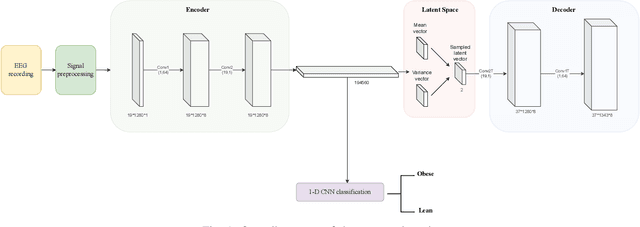
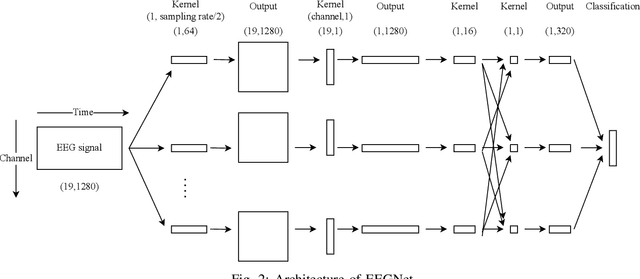


Abstract:Obesity is a common issue in modern societies today that can lead to various diseases and significantly reduced quality of life. Currently, research has been conducted to investigate resting state EEG (electroencephalogram) signals with an aim to identify possible neurological characteristics associated with obesity. In this study, we propose a deep learning-based framework to extract the resting state EEG features for obese and lean subject classification. Specifically, a novel variational autoencoder framework is employed to extract subject-invariant features from the raw EEG signals, which are then classified by a 1-D convolutional neural network. Comparing with conventional machine learning and deep learning methods, we demonstrate the superiority of using VAE for feature extraction, as reflected by the significantly improved classification accuracies, better visualizations and reduced impurity measures in the feature representations. Future work can be directed to gaining an in-depth understanding regarding the spatial patterns that have been learned by the proposed model from a neurological view, as well as improving the interpretability of the proposed model by allowing it to uncover any temporal-related information.
Finding neural signatures for obesity using source-localized EEG features
Aug 30, 2022
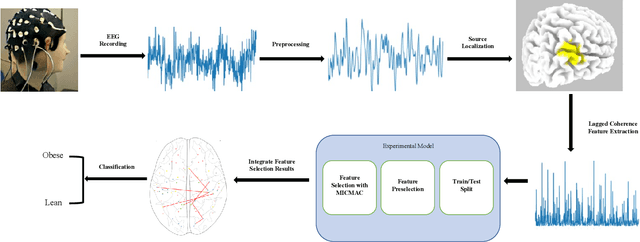
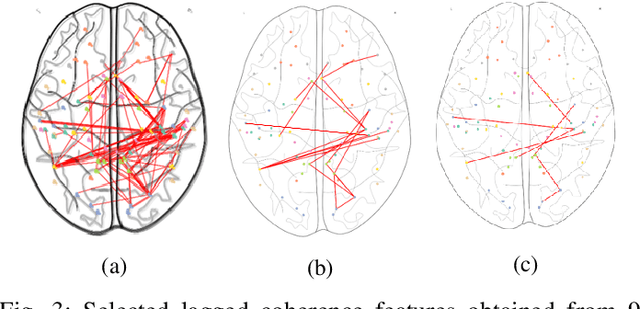
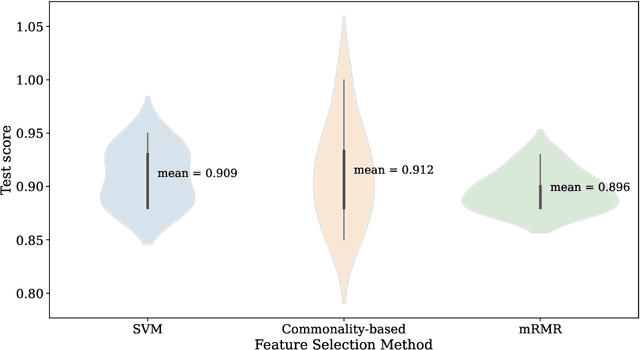
Abstract:Obesity is a serious issue in the modern society since it associates to a significantly reduced quality of life. Current research conducted to explore the obesity-related neurological evidences using electroencephalography (EEG) data are limited to traditional approaches. In this study, we developed a novel machine learning model to identify brain networks of obese females using alpha band functional connectivity features derived from EEG data. An overall classification accuracy of 90% is achieved. Our finding suggests that the obese brain is characterized by a dysfunctional network in which the areas that are responsible for processing self-referential information such as energy requirement are impaired.
Variational Transfer Learning using Cross-Domain Latent Modulation
May 31, 2022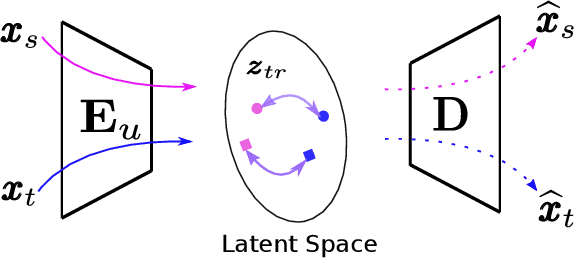
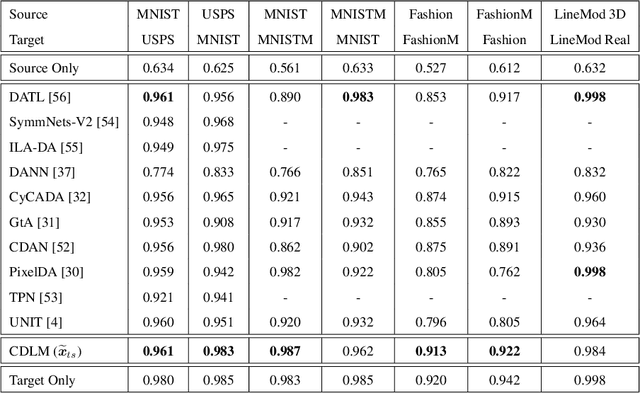
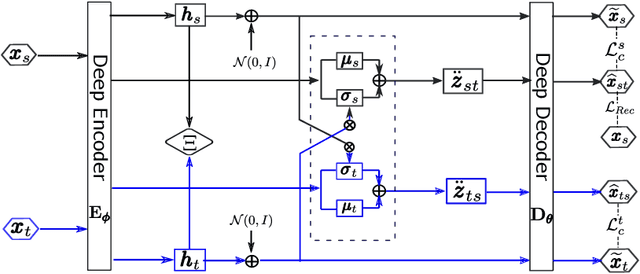
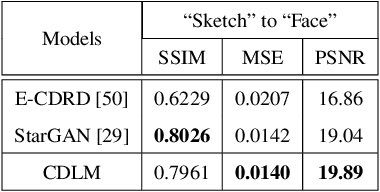
Abstract:To successfully apply trained neural network models to new domains, powerful transfer learning solutions are essential. We propose to introduce a novel cross-domain latent modulation mechanism to a variational autoencoder framework so as to achieve effective transfer learning. Our key idea is to procure deep representations from one data domain and use it to influence the reparameterization of the latent variable of another domain. Specifically, deep representations of the source and target domains are first extracted by a unified inference model and aligned by employing gradient reversal. The learned deep representations are then cross-modulated to the latent encoding of the alternative domain, where consistency constraints are also applied. In the empirical validation that includes a number of transfer learning benchmark tasks for unsupervised domain adaptation and image-to-image translation, our model demonstrates competitive performance, which is also supported by evidence obtained from visualization.
Semi-Supervised Semantic Segmentation of Vessel Images using Leaking Perturbations
Oct 22, 2021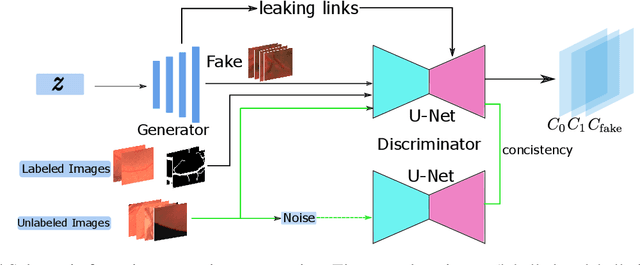

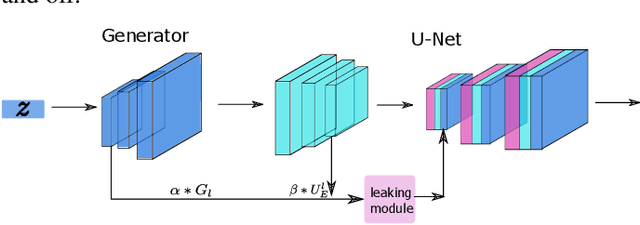

Abstract:Semantic segmentation based on deep learning methods can attain appealing accuracy provided large amounts of annotated samples. However, it remains a challenging task when only limited labelled data are available, which is especially common in medical imaging. In this paper, we propose to use Leaking GAN, a GAN-based semi-supervised architecture for retina vessel semantic segmentation. Our key idea is to pollute the discriminator by leaking information from the generator. This leads to more moderate generations that benefit the training of GAN. As a result, the unlabelled examples can be better utilized to boost the learning of the discriminator, which eventually leads to stronger classification performance. In addition, to overcome the variations in medical images, the mean-teacher mechanism is utilized as an auxiliary regularization of the discriminator. Further, we modify the focal loss to fit it as the consistency objective for mean-teacher regularizer. Extensive experiments demonstrate that the Leaking GAN framework achieves competitive performance compared to the state-of-the-art methods when evaluated on benchmark datasets including DRIVE, STARE and CHASE\_DB1, using as few as 8 labelled images in the semi-supervised setting. It also outperforms existing algorithms on cross-domain segmentation tasks.
Cross-Domain Latent Modulation for Variational Transfer Learning
Dec 21, 2020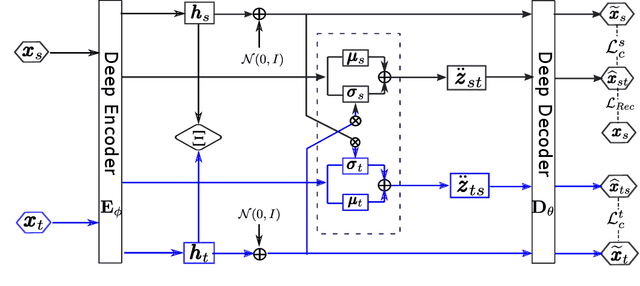

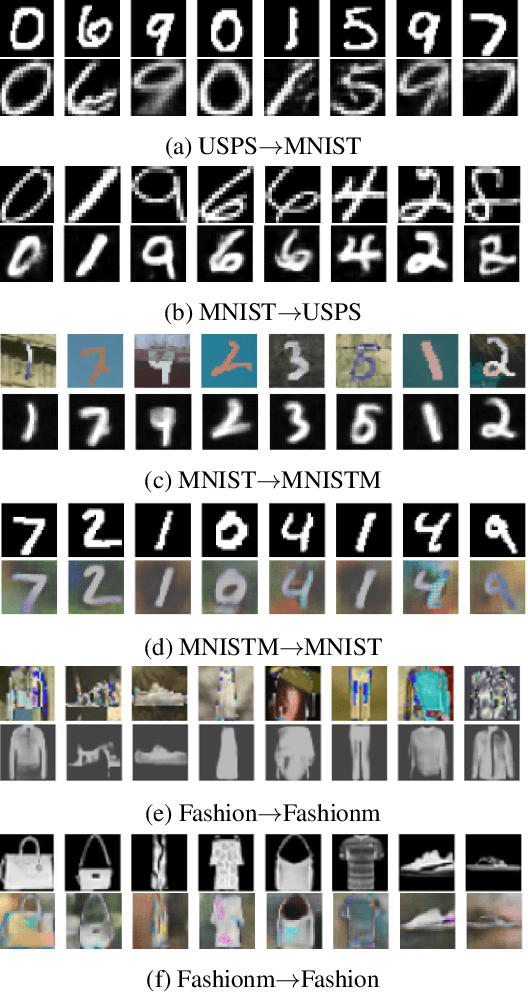
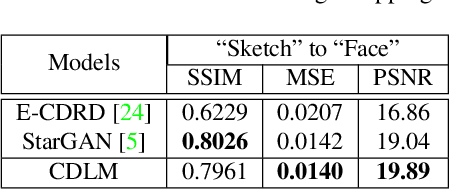
Abstract:We propose a cross-domain latent modulation mechanism within a variational autoencoders (VAE) framework to enable improved transfer learning. Our key idea is to procure deep representations from one data domain and use it as perturbation to the reparameterization of the latent variable in another domain. Specifically, deep representations of the source and target domains are first extracted by a unified inference model and aligned by employing gradient reversal. Second, the learned deep representations are cross-modulated to the latent encoding of the alternate domain. The consistency between the reconstruction from the modulated latent encoding and the generation using deep representation samples is then enforced in order to produce inter-class alignment in the latent space. We apply the proposed model to a number of transfer learning tasks including unsupervised domain adaptation and image-toimage translation. Experimental results show that our model gives competitive performance.
Resting-state EEG sex classification using selected brain connectivity representation
Dec 21, 2020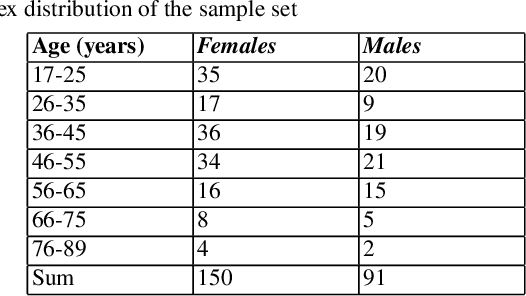
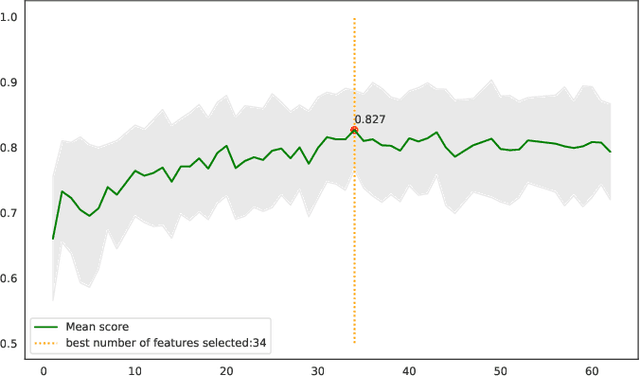
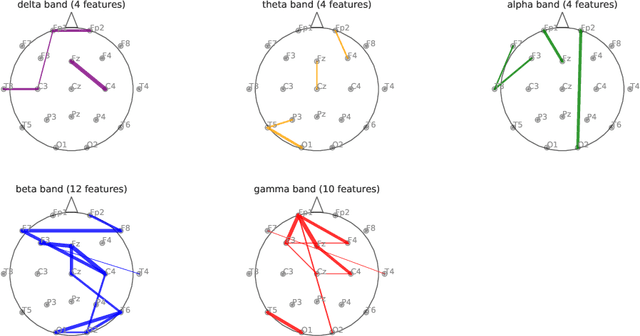
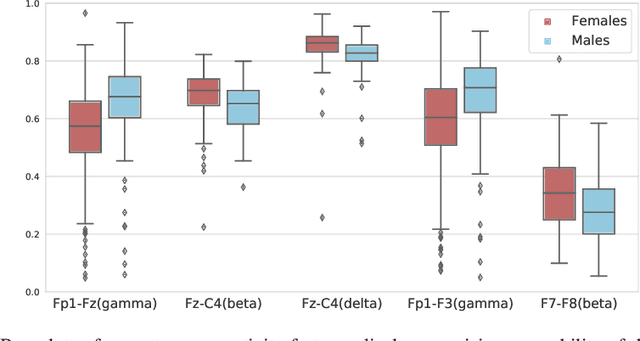
Abstract:Effective analysis of EEG signals for potential clinical applications remains a challenging task. So far, the analysis and conditioning of EEG have largely remained sex-neutral. This paper employs a machine learning approach to explore the evidence of sex effects on EEG signals, and confirms the generality of these effects by achieving successful sex prediction of resting-state EEG signals. We have found that the brain connectivity represented by the coherence between certain sensor channels are good predictors of sex.
Deep Adversarial Transition Learning using Cross-Grafted Generative Stacks
Sep 25, 2020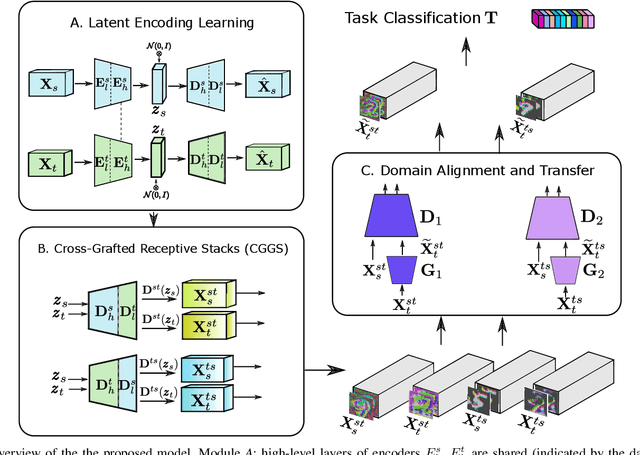

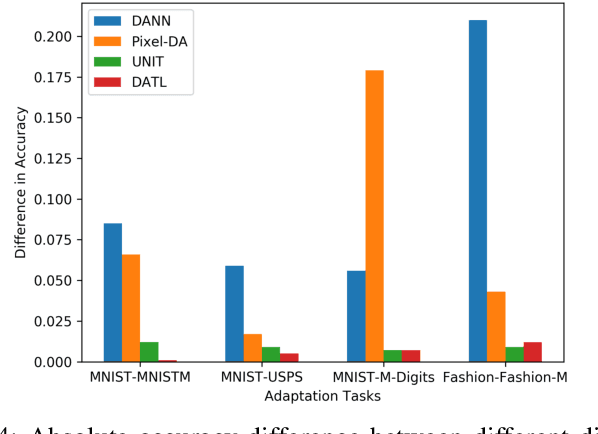
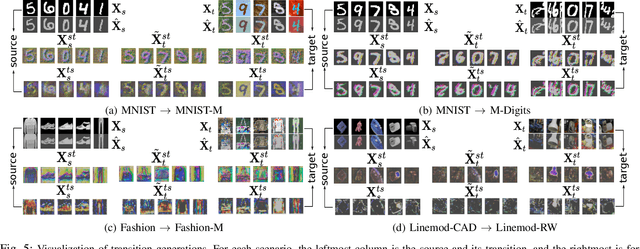
Abstract:Current deep domain adaptation methods used in computer vision have mainly focused on learning discriminative and domain-invariant features across different domains. In this paper, we present a novel "deep adversarial transition learning" (DATL) framework that bridges the domain gap by projecting the source and target domains into intermediate, transitional spaces through the employment of adjustable, cross-grafted generative network stacks and effective adversarial learning between transitions. Specifically, we construct variational auto-encoders (VAE) for the two domains, and form bidirectional transitions by cross-grafting the VAEs' decoder stacks. Furthermore, generative adversarial networks (GAN) are employed for domain adaptation, mapping the target domain data to the known label space of the source domain. The overall adaptation process hence consists of three phases: feature representation learning by VAEs, transitions generation, and transitions alignment by GANs. Experimental results demonstrate that our method outperforms the state-of-the art on a number of unsupervised domain adaptation benchmarks.
Unsupervised Domain Adaptation using Deep Networks with Cross-Grafted Stacks
Mar 25, 2019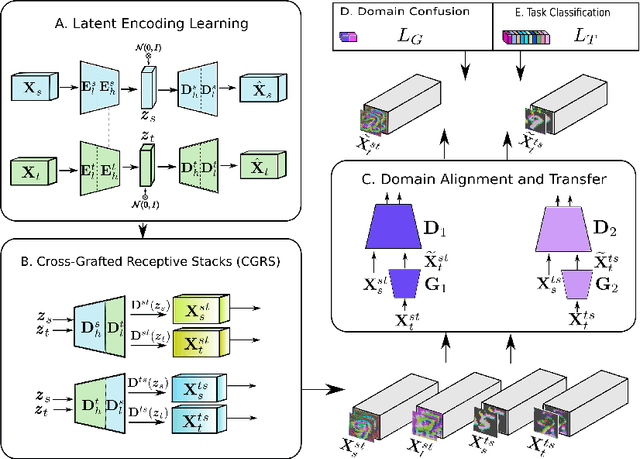
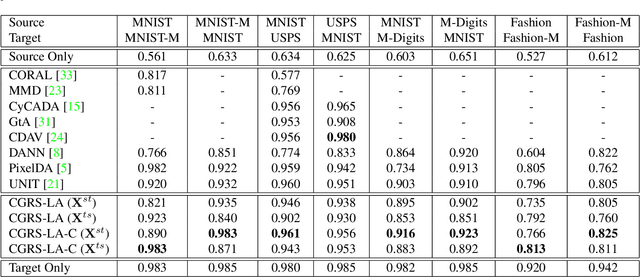


Abstract:Current deep domain adaptation methods used in computer vision have mainly focused on learning discriminative and domain-invariant features across different domains. In this paper, we present a novel approach that bridges the domain gap by projecting the source and target domains into a common association space through an unsupervised ``cross-grafted representation stacking'' (CGRS) mechanism. Specifically, we construct variational auto-encoders (VAE) for the two domains, and form bidirectional associations by cross-grafting the VAEs' decoder stacks. Furthermore, generative adversarial networks (GAN) are employed for label alignment (LA), mapping the target domain data to the known label space of the source domain. The overall adaptation process hence consists of three phases: feature representation learning by VAEs, association generation, and association label alignment by GANs. Experimental results demonstrate that our CGRS-LA approach outperforms the state-of-the-art on a number of unsupervised domain adaptation benchmarks.
 Add to Chrome
Add to Chrome Add to Firefox
Add to Firefox Add to Edge
Add to Edge